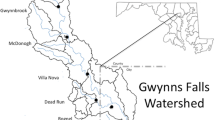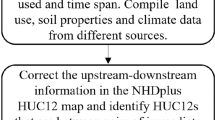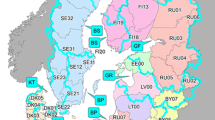Abstract
Regional Spatially Referenced Regressions on Watershed models were used to update 2002 delivered nitrogen (N) loads to estuaries of the contiguous US for 2011, supplemented by direct estuarine atmospheric deposition from the Community Multiscale Air Quality Model. Median 2011 watershed N yields were greatest for the Puget Trough, Virginian, and Oregon–Washington–Vancouver Coast marine ecoregions (MEs; 13.7, 11.0, and 9.9 kg N/ha watershed/year, respectively); intermediate for the Floridian, Southern California Bight, and Northern California MEs (4.4–6.3 kg N/ha watershed/year); and lowest for the Northern Gulf of Mexico, Carolinian, and Gulf of Maine MEs (2.4–3.2 kg N/ha watershed/year). Dominant sources varied across marine ecoregions, with direct atmospheric deposition as the dominant source only in the far northern Gulf of Maine ME. Delivered N loads from atmospheric deposition have significantly decreased (p < 0.05) for most estuaries on the Atlantic and Gulf coasts for 2002–2012. Estimated point source delivered N loads for 2002–2012 increased for most estuaries with upstream treatment plants, with estimated loads to only seven estuaries decreasing by more than 50%. Urban runoff increased for most estuaries in the Puget Trough and Carolinian MEs and either increased or had no significant trend for the remaining marine ecoregions. The magnitude of change in total N delivered loads is uncertain due to incomplete monitoring for most minor dischargers. In areas with increased population growth and decreases in agricultural land, decreasing agricultural fertilizer inputs have been insufficient to offset increases in urban runoff.







Similar content being viewed by others
References
Abdelrhman, M. 2007. Embayment characteristic time and biology via tidal prism model. Estuarine, Coastal and Shelf Science 74 (4): 742–755.
Alam, M.J., and J.L. Goodall. 2012. Toward disentangling the effect of hydrologic and nitrogen source changes from 1992 to 2001 on incremental nitrogen yield in the contiguous United States. Water Resources Research 48: W04506. https://doi.org/10.1029/2011WRO010967.2012.
Alam, M.J., J.L. Goodall, B.D. Bowes, and E.G. Girvetz. 2017. The impact of projected climate change scenarios on nitrogen yield at a regional scale for the contiguous United States. JAWRA 53 (4): 854–870.
Alexander, R.B., R.A. Smith, and G.E. Schwarz. 2000. Effect of stream channel size on the delivery of nitrogen to the Gulf of Mexico. Nature 403: 758–761.
Beachley, G., M. Puchalski, C. Rogers, and G. Lear. 2016. A summary of long-term trends in sulfur and nitrogen deposition in the United States: 1990-2013. JSM Environ Sci Ecol 4 (2): 1030.
Beck, M.W., T.W. Jabusch, P.R. Trowbridge, and D.B. Senn. 2018. Four decades of water quality change in the upper San Francisco estuary. Estuarine, Coastal and Shelf Science 212: 11–22.
Beusen, A.H.W., C.P. Slomp, and A.F. Bouwman. 2013. Global land-ocean linkage: Direct inputs of nitrogen to coastal waters via submarine groundwater discharge. Environmental Research Letters 8: 034035.
Brakebill, J.W., and S.E. Terziotti. 2011. A digital hydrologic network supporting NAWQA MRB SPARROW modeling—MRB_E2RF1. Version 1.0. Reston, VA: U.S. Geological Survey https://water.usgs.gov/lookup/getspatial?mrb_e2rf1.
Breitburg, D.L., D.W. Hondorp, L.A. Davias, and R.J. Diaz. 2009. Hypoxia, nitrogen, and fisheries: Interpreting effects across local and global landscapes. Annual Review of Marine Science 1: 329–349. https://doi.org/10.1146/annurev.marine.010908.163754.
Bricker, S.B., B. Longstaff, W. Dennison, A. Jones, K. Boicourt, C. Wicks, et al. 2007. Effects of nutrient enrichment in the nation’s estuaries: A decade of change. NOAA Coastal Ocean Program, Decision Analysis Series 26. Silver Spring, MD: National Centers for Coastal Ocean Science.
Byun, D., and K.L. Schere. 2006. Review of the governing equations, computational algorithms, and other components of the models-3 Community Multiscale Air Quality (CMAQ) modeling system. Applied Mechanics Reviews 59: 51e77.
Cleveland, C.C., A.R. Townsend, D.S. Schimel, H. Fisher, R.W. Howarth, L.O. Hedin, S.S. Perakis, E.F. Latty, J.C. Von Fischer, A. Elseroad, and M.F. Wasson. 1999. Global patterns of terrestrial biological nitrogen (N2) fixation in natural ecosystems. Global Biogeochem Cycles 13: 623–645.
Cloern, J.E. 1982. Does the benthos control phytoplankton biomass in South San Francisco Bay? Marine Ecology 9 (2): 191–202.
Cortini, F., P.G. Comeau, T. Wang, D.E. Hibbs, and A. Bluhm. 2012. Climate effects on red alder growth in the Pacific Northwest of North America. Forest Ecology and Management 277: 98–106.
De Cicco, L.A., Sprague, L.A., Murphy, J.C., Riskin, M.L., Falcone, J.A., Stets, E.G., Oelsner, G.P., and Johnson, H.M., 2017, Water-quality and streamflow datasets used in the Weighted Regressions on Time, Discharge, and Season (WRTDS) models to determine trends in the Nation’s rivers and streams, 1972-2012 (ver. 1.1 July 7, 2017): U.S. Geological Survey data release, doi: https://doi.org/10.5066/F7KW5D4H.
Deacutis, C.F., D. Murray, W. Prell, E. Saarman, and L. Korhun. 2006. Hypoxia in the upper half of Narragansett Bay, RI, during August 2001 and 2002. Northeastern Naturalist 13 (4): 173–198.
Detenbeck, N, M. Pelletier, N. ten Brink, M. Abdelrhman, and S. Rego. 2009 E-estuary: Developing a decision-support system for coastal management in the conterminous United States. Proceedings, 33rd IAHR 2009 Congress - Water Engineering for a Sustainable Environment. Vancouver, BC. 5284–5292.
Diaz, R.J., and R. Rosenberg. 2008. Spreading dead zones and consequences for marine ecosystems. Science 2008 321 (5891): 926–929.
Eshleman, K.N., R.D. Sabo, and K.M. Kline. 2013. Surface water quality is improving due to declining atmospheric N deposition. Environmental Science and Technology 47: 12193–12200.
Evans, M.A., and D. Scavia. 2013. Exploring estuarine eutrophication sensitivity to nutrient loading. Limnology and Oceanography 58 (2): 569–578.
Fenn, M.E., J.S. Baron, E.B. Allen, H.M. Rueth, K.R. Nydick, L. Geiser, W.D. Bowman, J.O. Sickman, T. Meixner, D.W. Johnson, and P. Neitlich. 2003. Ecological effects of nitrogen deposition in the western United States. BioScience 53: 404–420.
FGDC. 2012. Coastal and marine ecological classification standard. Marine and Coastal Spatial Data Subcommittee Federal Geographic Data Committee Washington, DC. FGDC-STD-018-2012.
García, A.M., R.B. Alexander, J.G. Arnold, L. Norfleet, M.J. White, D.M. Robertson, and G. Schwarz. 2016. Regional effects of agricultural conservation practices on nutrient transport in the Upper Mississippi River Basin. Environmental Science & Technology 50: 6991–7000.
Hickman, R.E., 2017, Input data and results of WRTDS models and seasonal rank-sum tests to determine trends in the quality of water in New Jersey streams, water years 1971–2011: U.S. Geological Survey data release, doi: https://doi.org/10.5066/F7NS0RZ3.
Hickman, R.E., and R.M. Hirsch. 2017. Trends in the quality of water in New Jersey streams, water years 1971–2011. U.S. Geological Survey Scientific Investigations Report 2016–5176: 58. https://doi.org/10.3133/sir20165176.
Hoos, A.B., R.B. Moore, A.M. Garcia, G.B. Noe, S.E. Terziotti, C.M. Johnston, and R.L. Dennis. 2013. Simulating stream transport of nutrients in the eastern United States, 2002, using a spatially-referenced regression model and 1:100,000-scale hydrography. U.S. Geological Survey Scientific Investigations Report 2013–5102, 33 p., http://pubs.usgs.gov/sir/2013/5102/.
Howarth, R.W. 2008. Coastal nitrogen pollution: A review of sources and trends globally and regionally. Harmful Algae 8: 14–20.
Howarth, R.W., G. Billen, D. Swaney, A. Townsend, N. Jaworski, K. Lajtha, et al. 1996. Regional nitrogen budgets and riverine N and P fluxes for the drainages to the North Atlantic Ocean: Natural and human influences. Biogeochemistry 35: 75–139. https://doi.org/10.1007/BF02179825.
Howarth, R.W., D.P. Swaney, E.W. Boyer, R.M. Marino, N. Jaworski, and C.L. Goodale. 2006. The influence of climate on average nitrogen export from large watersheds in the northeastern United States. Biogeochemistry. 79: 163–186.
HTF (Hypoxia Task Force). 2016. Report on point source progress in hypoxia task force states. Febr. 2016. Available at: https://www.epa.gov/sites/production/files/2016-03/documents/htf_pointsource_progressreport_02-25-16_508.pdf
Kim, I.-N., K. Lee, N. Gruber, D.M. Karl, J.L. Bullister, S. Yang, and T.-W. Kim. 2014. Increasing anthropogenic nitrogen in the North Pacific Ocean. Science 346 (6213): 1102–1106.
Kurtz, J., N.E. Detenbeck, V.D. Engle, K.T. Ho, L.M. Smith, S.J. Jordan, and D. Campbell. 2006. Classifying coastal waters: Current necessity and historical perspective. Estuaries. 29 (1): 107–123.
Liu, Y., P. MacCready, and B.M. Hickey. 2009. Columbia River plume patterns in summer 2004 as revealed by a hindcast coastal ocean circulation model. Geophysical Research Letters 36: L02601. https://doi.org/10.1029/2008GL036447.
Liu, X., Y. Zhang, W.Han.A. Tang, J. Shen, Z. Cui, P. Vitousek, J.W. Erisnam, K. Goulding, P. Christie, A. Fangmeier, and F. Zhang. 2013. Enhanced nitrogen deposition over China. Nature 494: 459–463.
Lloret, J., and I. Valiela. 2016. Unprecedented decrease in deposition of nitrogen oxides over North America: The relative effects of emission controls and prevailing air-mass trajectories. Biogeochemistry 129: 165–180.
Maupin, M.A., and T. Ivahnenko. 2011. Nutrient loadings to streams of the continental United States from municipal and industrial effluent. Journal of the American Water Resources Association (JAWRA) 47 (5): 950–964. https://doi.org/10.1111/j.1752-1688.2011.00576.x.
Mayorga, E., S. Seitzinger, A.F. Harrison, E. Dumont, A.H.W. Beusen, A.F. Bouwman, et al. 2010. Global nutrient export from WaterSheds 2 (NEWS 2): Model development and implementation. Environmental Modelling and Software. https://doi.org/10.1016/j.envsoft.2010.1001.1007.
McCrackin, M.L., J.A. Harrison, and J.E. Compton. 2013. A comparison of NEWS and SPARROW models to understand sources of nitrogen delivered to US coastal areas. Biogeochemistry 114: 281–297.
McCrackin, M.L., J.A. Harrison, and J.E. Compton. 2015. Future riverine nitrogen export to coastal regions in the United States: Prospects for improving water quality. JEQ 44: 345–355.
Moore, R.B., and T.G. Dewald. 2016. The road to NHDPlus—Advancements in digital stream networks and associated catchments. Journal of the American Water Resources Association (JAWRA) 52 (4): 890–900. https://doi.org/10.1111/1752-1688.12389.
Moorman, M.C., A.B. Hoos, S.B. Bricker, R.B. Moore, A.M. García, and S.W. Ator. 2014. Nutrient load summaries for major lakes and estuaries of the Eastern United States, 2002: U.S. Geological Survey Data Series 820, 94 p., doi: https://doi.org/10.3133/ds82 https://water.usgs.gov/nawqa/sparrow/estuary/index.html0.
Murphy, J.C., and L.A. Sprague. 2019. Water-quality trends in U.S. rivers: Exploring effects from streamflow trends and changes in watershed management. Science of the Total Environment 656: 645–658.
Narragansett Bay Estuary Program. 2017. State of Narragansett Bay and its watershed (Chapter 8, nutrient loading, pages 166–189). Technical report. Providence, RI.
Oelsner, G.P., Sprague, L.A., Murphy, J.C., Zuellig, R.E., Johnson, H.M., Ryberg, K.R., Falcone, J.A., Stets, E.G., Vecchia, A.V., Riskin, M.L., De Cicco, L.A., Mills, T.J., Farmer, W.H., 2017, Water-quality trends in the nation’s rivers and streams 1972–2012—Data preparation, statistical methods, and trend results: U.S. Geological Survey Scientific Investigations Report, doi: https://doi.org/10.3133/sir20175006.
Pennock, J.R. 1985. Chlorophyll distributions in the Delaware Estuary: Regulation by light-limitation. Estuarine, Coastal and Shelf Science 21: 711–725.
Pohlert, T. 2018. Non-parametric trend tests and change-point detection. citation(package="trend").
PREP (Piscatagua Region Estuaries Partnership). 2018. Environmental data report: Technical support document for the 2018 State of Our Estuaries Report. Available at www.PREPestuaries.org.
Preston, S.D., R.B. Alexander, and D.M. Wolock. 2011. SPARROW modeling to understand water-quality conditions in major regions of the United States: A featured collection introduction. Journal of the American Water Resources Association (JAWRA) 47 (5): 887–890. https://doi.org/10.1111/j.1752-1688.2011.00585.x.
Pritchard, D.W. 1967. What is an estuary: Physical viewpoint. In Lauf, G. H. Estuaries. A.A.A.S. Publ. 83. Washington, DC. pp. 3–5.
Puntsag, T., M.J. Mitchell, J.L. Campbell, et al. 2016. Arctic vortex changes alter the sources and isotopic values of precipitation in northeastern US. Scientific Reports 6: 22647. https://doi.org/10.1038/srep22647.
Rebich, R.A., N.A. Houston, S.V. Mize, D.K. Pearson, P.B. Ging, and C.E. Hornig. 2011. Sources and delivery of nutrients to the northwestern Gulf of Mexico from streams in the south-central United States. Journal of the American Water Resources Association (JAWRA) 47 (5): 1061–1086. https://doi.org/10.1111/j.1752-1688.2011.00583.x.
SAB (U.S. Environmental Protection Agency Science Advisory Board). 2007. Hypoxia in the northern Gulf of Mexico: An update by the EPA Science Advisory Board. EPA-SAB-08-003. Washington, D.C.: U.S. Environmental Protection Agency Science Advisory Board.
Saleh, D., and J. Domagalski. 2015. SPARROW modeling of nitrogen sources and transport in rivers and streams of California and adjacent states, U.S. JAWRA 51 (6): 1487–1507.
Schwarz, G.E., A.B. Hoos, R.B. Alexander, and R.A. Smith. 2006. The SPARROW surface water-quality model: Theory, application, and user documentation, U.S. Geological Survey Techniques and Methods Report, Book 6, Chapter B3.
Schwede, D.B., and G.G. Lear. 2014. A novel hybrid approach for estimating total deposition in the United States. Atmospheric Environment 92: 207–220.
Sinha, E., and A.M. Michalak. 2016. Precipitation dominates interannual variability of riverine nitrogen loading across the continental United States. Environmental Science & Technology 50: 12874–12884. https://doi.org/10.1021/acs.est.6b04455.
Sinha, E., A.M. Michalak, and V. Balaji. 2017. Eutrophication will increase during the 21st century as a result of precipitation changes. Science 357 (6349): 405–408.
Smith, R., J. Brakebill, G. Schwarz, R. Alexander, M. Hirsch, A. Nolin, M. Macauley, Q. Zhang, J Shih, W. Wang, and E. Sproles. 2011. Dynamic SPARROW modeling of nitrogen flux with climate and MODIS vegetation indices as drivers. AGU Fall Meeting Abstracts. 1378.
Spalding, M.D., H.E. Fox, G.R. Allen, N. Davidson, Z.A. Ferdaña, M. Finlayson, B.S. Halpern, M.A. Jorge, A. Lombana, S.A. Lourie, K.D. Martin, E. McManus, J. Molnar, C.A. Recchia, and J. Robertson. 2007. Marine ecoregions of the world: A bioregionalization of coastal and shelf areas. BioScience 57 (7): 573–583.
Swaney, D.P., R.W. Howarth, and B. Hong. 2018. Nitrogen use efficiency and crop production: Patterns of regional variation in the United States, 1987 – 2012. Science of the Total Environment 635: 498–511.
US EPA. 2004. Coastal classification framework. National Health and Environmental Effects Research Laboratory. Atlantic, Gulf, and Mid-Continent Ecology Divisions. EPA Report 600/R-04/061.
US EPA. 2010a. Nutrient criteria technical guidance manual estuarine and coastal marine waters. United States Environmental Protection Agency Office of Water. EPA-822-B-01-003. October 2001.
US EPA. 2010b. Nutrients in estuaries: A summary report of the National Estuarine Experts Workgroup 2005–2007. Washington, D.C.: U.S. Environmental Protection Agency.
US EPA. 2011. Reactive nitrogen in the United States: An analysis of inputs, flows, consequences, and management options, EPA-SAB-11-013; EPA Science Advisory Board; p 140.
US EPA. 2012. Technical users background document for the discharge monitoring report (DMR) pollutant loading tool version 1.0 Washington, D.C.: U.S. Environmental Protection Agency. Available at: https://echo.epa.gov/system/files/Technical_Users_Background_Doc.pdf
US EPA. 2014. Clean air markets progress report NOx emissions reductions. (Available at: https://www3.epa.gov/airmarkets/progress/reports/emissions_reductions_nox.html#figure1).
US EPA. 2015. Office of Water and Office of Research and Development. (2015). National coastal condition assessment 2010 (EPA 841-R-15-006). Washington, DC. December 2015.
US EPA. 2016. Clean watershed needs survey 2012: Report to Congress. U.S. Environmental Protection Agency, Washington, DC. EPA-830-R-15005.
US EPA. 2017a. Mississippi River/Gulf of Mexico Watershed Nutrient Task Force 2017 report to congress: Second biennial report. August 2017.
US EPA. 2017b. Action towards limiting total nitrogen, total phosphorus, and total inorganic nitrogen loads from NPDES-permitted facilities. Accessed 7/13/18 from https://19january2017snapshot.epa.gov/nutrient-policy-data/action-towards-limiting-total-nitrogen-total-phosphorus-and-total-inorganic_.html.
Van Meter, K.J., P. Van Cappellen, and N.B. Basu. 2018. Legacy nitrogen may prevent achievement of water quality goals in the Gulf of Mexico. Science 22 Mar 2018: eaar4462. https://doi.org/10.1126/science.aar4462.
Wan, Y., L. Wan, Y. Li, and P. Doering. 2017. Decadal and seasonal trends of nutrient concentration and export from highly managed coastal catchments. Water Research 115: 180–194.
Wasson, K., R. Jeppesen, C. Endris, D.C. Perry, A. Woolfook, K. Beheshti, M. Rodriguez, R. Eby, E.B. Watshon, F. Rahman, J. Haskins, and B.B. Hughes. 2017. Eutrophication decreases salt marsh resilience through proliferation of algal mats. Biological Conservation 212: 1–11.
Williamson, S.C., J.E. Rheuban, J.E. Costa, D.M. Glover, and S.C. Doney. 2017. Assessing the impact of local and regional influences on nitrogen loads to Buzzards Bay. Frontiers in Marine Science 3: 1–17.
Wise, D.R., and Johnson, H.M., 2013, Application of the SPARROW model to assess surface-water nutrient conditions and sources in the United States Pacific Northwest: U.S. Geological Survey Scientific Investigations Report 2013–5103, 32 p., http://pubs.usgs.gov/sir/2013/5103/.
Yagecic, J.R., D. Sayers, P.J. V’Combe, S. McAleer, and C. Pindar. 2016. Impact of treatment plant type on point discharge effluent nutrient concentrations in the Delaware River basin. West Trenton, NJ: Delaware River Basin Commission.
Zhang, Y.R. Mathur, J.O. Bash, C. Hogrefe, J. Xing, and S.J. Roselle. 2018. Long-term trends in total inorganic nitrogen and sulfur deposition in the U.S. from 1990 to 2010. Atmospheric Chemistry and Physics Discussions. https://doi.org/10.5194/acp-2018-116.
Acknowledgments
This is contribution number ORD-027336 of the Atlantic Ecology Division, National Health and Environmental Effects Research Laboratory, Office of Research and Development, U.S. Environmental Protection Agency (US EPA). The views expressed in this article are those of the authors and do not necessarily reflect the views or policies of the US EPA. Mention of trade names or commercial products does not constitute endorsement or recommendation for use. The authors thank Drs. Brenda Rashleigh, Daniel Campbell, and Galen Kaufman for providing preliminary technical reviews of this manuscript as well as the two anonymous reviewers of the final publication.
Funding
Support for this work (funding for ORISE participants through an interagency agreement with the Department of Energy - Oak Ridge Associated Universities) was provided by the USEPA through the Integrated Nitrogen Project under US EPA Safe and Healthy Communities research program. The information in this document has been funded wholly by the US EPA.
Author information
Authors and Affiliations
Corresponding author
Ethics declarations
Conflict of Interest
The authors declare that they have no conflict of interest.
Additional information
Communicated by Dennis Swaney
Mingde You and Daniel Torre are former ORISE participant at US EPA, Narragansett, RI.
Rights and permissions
About this article
Cite this article
Detenbeck, N.E., You, M. & Torre, D. Recent Changes in Nitrogen Sources and Load Components to Estuaries of the Contiguous United States. Estuaries and Coasts 42, 2096–2113 (2019). https://doi.org/10.1007/s12237-019-00614-1
Received:
Published:
Issue Date:
DOI: https://doi.org/10.1007/s12237-019-00614-1




